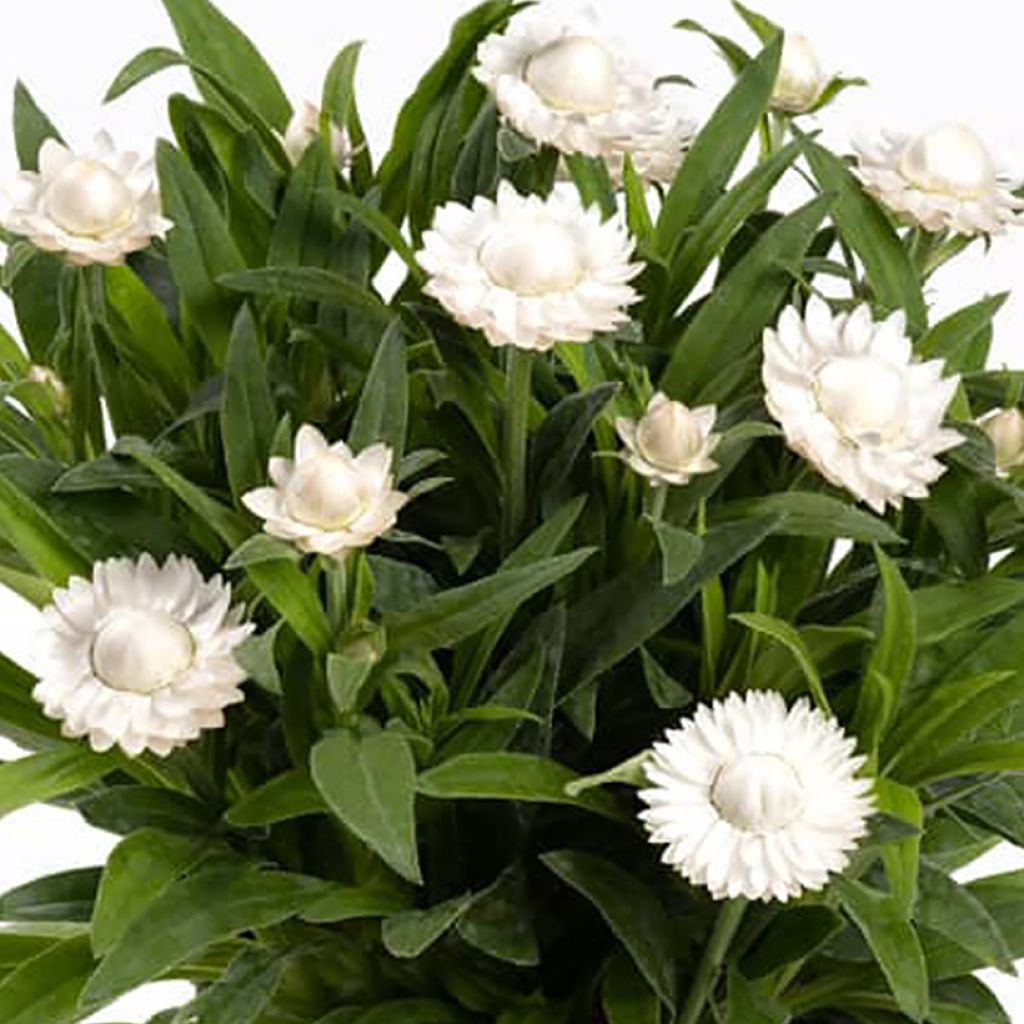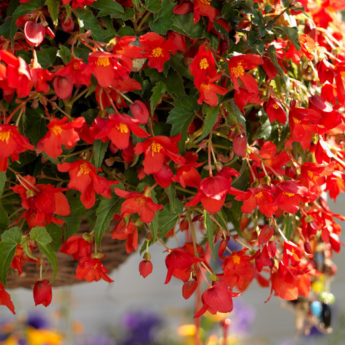

Bracteantha Heliana White - Immortelle
Bracteantha bracteata Heliana White - Strawflower
Bracteantha bracteata Heliana White
Strawflower, Everlasting, Paper Daisy
This plant carries a 6 months recovery warranty
More information
We guarantee the quality of our plants for a full growing cycle, and will replace at our expense any plant that fails to recover under normal climatic and planting conditions.
Would this plant suit my garden?
Set up your Plantfit profile →
Description
The Bracteantha Heliana White brings the elegance of pearly white to this series of exceptionally floriferous hybrid Heliana everlasting flowers. The plant grows into a very dense, neat-looking small tuft, and its particularly long flowering compensates for the modest size of its flowers. It is a remarkably generous annual that forms a beautiful, very flowery cushion for almost 5 months without the need to remove faded flowers. In borders or pots, its pure pearly flowers illuminate any decor. They are also perfect for fresh or dried bouquets.
The Bracteantha Heliana White is a very recent horticultural achievement, a hybrid that does not produce seeds but devotes all its energy to flowering. It is an annual plant from the Asteraceae family: it has flowers organized in heads, but the heads of the everlasting flowers are distinguished from daisies and centaureas by the absence of ray flowers or petals, which are replaced by scaly, coloured, and shiny bracts. This characteristic allows the inflorescences to hold up for a long time once they are dry, as the bracts do not 'wither' like petals. The Heliana White selection is an upright, compact plant that reaches an average height of 35 cm when in flower, with a width of 20-25 cm (8-10in). Its rough stems are branched, adorned with simple, lanceolate, olive-green leaves, slightly hairy, measuring 5 to 7 cm (2 to 3in) long. The overall appearance is a dense tuft. Flowering is uninterrupted from summer to autumn, usually from June to October. It is nectar-rich and highly visited by butterflies. The Heliana White heads measure between 2 and 3 cm (1in) in diameter.
Report an error about the product description
Flowering
Foliage
Plant habit
Botanical data
Bracteantha
bracteata
Heliana White
Asteraceae
Strawflower, Everlasting, Paper Daisy
Cultivar or hybrid
Planting and care
You can plant your Heliana White everlastings in the ground or in a pot. If you plant them in the ground, wait until the last frosts have passed (they tolerate a little frost). In the meantime, you can pre-cultivate them in a pot in a warm and bright place to speed up their growth. Plant them in a sunny location. They need a light and humus-rich soil and appreciate a fertilizer input. They tolerate a soil that is occasionally dry. In pots, they need to be regularly watered. Everlastings do not appreciate very humid summers that can cause their flowers and foliage to rot.
Planting period
Intended location
Care
Planting & care advice
This item has not been reviewed yet - be the first to leave a review about it.
Haven't found what you were looking for?
Hardiness is the lowest winter temperature a plant can endure without suffering serious damage or even dying. However, hardiness is affected by location (a sheltered area, such as a patio), protection (winter cover) and soil type (hardiness is improved by well-drained soil).

Photo Sharing Terms & Conditions
In order to encourage gardeners to interact and share their experiences, Promesse de fleurs offers various media enabling content to be uploaded onto its Site - in particular via the ‘Photo sharing’ module.
The User agrees to refrain from:
- Posting any content that is illegal, prejudicial, insulting, racist, inciteful to hatred, revisionist, contrary to public decency, that infringes on privacy or on the privacy rights of third parties, in particular the publicity rights of persons and goods, intellectual property rights, or the right to privacy.
- Submitting content on behalf of a third party;
- Impersonate the identity of a third party and/or publish any personal information about a third party;
In general, the User undertakes to refrain from any unethical behaviour.
All Content (in particular text, comments, files, images, photos, videos, creative works, etc.), which may be subject to property or intellectual property rights, image or other private rights, shall remain the property of the User, subject to the limited rights granted by the terms of the licence granted by Promesse de fleurs as stated below. Users are at liberty to publish or not to publish such Content on the Site, notably via the ‘Photo Sharing’ facility, and accept that this Content shall be made public and freely accessible, notably on the Internet.
Users further acknowledge, undertake to have ,and guarantee that they hold all necessary rights and permissions to publish such material on the Site, in particular with regard to the legislation in force pertaining to any privacy, property, intellectual property, image, or contractual rights, or rights of any other nature. By publishing such Content on the Site, Users acknowledge accepting full liability as publishers of the Content within the meaning of the law, and grant Promesse de fleurs, free of charge, an inclusive, worldwide licence for the said Content for the entire duration of its publication, including all reproduction, representation, up/downloading, displaying, performing, transmission, and storage rights.
Users also grant permission for their name to be linked to the Content and accept that this link may not always be made available.
By engaging in posting material, Users consent to their Content becoming automatically accessible on the Internet, in particular on other sites and/or blogs and/or web pages of the Promesse de fleurs site, including in particular social pages and the Promesse de fleurs catalogue.
Users may secure the removal of entrusted content free of charge by issuing a simple request via our contact form.
The flowering period indicated on our website applies to countries and regions located in USDA zone 8 (France, the United Kingdom, Ireland, the Netherlands, etc.)
It will vary according to where you live:
- In zones 9 to 10 (Italy, Spain, Greece, etc.), flowering will occur about 2 to 4 weeks earlier.
- In zones 6 to 7 (Germany, Poland, Slovenia, and lower mountainous regions), flowering will be delayed by 2 to 3 weeks.
- In zone 5 (Central Europe, Scandinavia), blooming will be delayed by 3 to 5 weeks.
In temperate climates, pruning of spring-flowering shrubs (forsythia, spireas, etc.) should be done just after flowering.
Pruning of summer-flowering shrubs (Indian Lilac, Perovskia, etc.) can be done in winter or spring.
In cold regions as well as with frost-sensitive plants, avoid pruning too early when severe frosts may still occur.
The planting period indicated on our website applies to countries and regions located in USDA zone 8 (France, United Kingdom, Ireland, Netherlands).
It will vary according to where you live:
- In Mediterranean zones (Marseille, Madrid, Milan, etc.), autumn and winter are the best planting periods.
- In continental zones (Strasbourg, Munich, Vienna, etc.), delay planting by 2 to 3 weeks in spring and bring it forward by 2 to 4 weeks in autumn.
- In mountainous regions (the Alps, Pyrenees, Carpathians, etc.), it is best to plant in late spring (May-June) or late summer (August-September).
The harvesting period indicated on our website applies to countries and regions in USDA zone 8 (France, England, Ireland, the Netherlands).
In colder areas (Scandinavia, Poland, Austria...) fruit and vegetable harvests are likely to be delayed by 3-4 weeks.
In warmer areas (Italy, Spain, Greece, etc.), harvesting will probably take place earlier, depending on weather conditions.
The sowing periods indicated on our website apply to countries and regions within USDA Zone 8 (France, UK, Ireland, Netherlands).
In colder areas (Scandinavia, Poland, Austria...), delay any outdoor sowing by 3-4 weeks, or sow under glass.
In warmer climes (Italy, Spain, Greece, etc.), bring outdoor sowing forward by a few weeks.



































